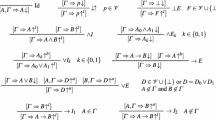Abstract
Natural deduction (for short: nd-) calculi have not been used systematically as a basis for automated theorem proving in classical logic. To remove objective obstacles to their use we describe (1) a method that allows to give semantic proofs of normal form theorems for nd-calculi and (2) a framework that allows to search directly for normal nd-proofs. Thus, one can try to answer the question: How do we bridge the gap between claims and assumptions in heuristically motivated ways? This informal question motivates the formulation of intercalation calculi. Ic-calculi are the technical underpinnings for (1) and (2), and our paper focuses on their detailed presentation and meta-mathematical investigation in the case of classical predicate logic. As a central theme emerges the connection between restricted forms of nd-proofs and (strategies for) proof search: normal forms are not obtained by removing local "detours", but rather by constructing proofs that directly reflect proof-strategic considerations. That theme warrants further investigation.
Similar content being viewed by others
References
Andrews, P., 'Transforming matings into natural deduction proofs', in 5th Conference on Automated Deduction, 281-292, New York, Berlin, Springer-Verlag, 1980.
Baaz M., and C. G. FermÜller, 'Non-elementary speedups between different versions of tableaux', in Baumgartner et al., editors, Theorem Proving with Analytic Tableaux and Related Methods, 217-230. Springer, 1995.
Bledsoe, W., 'Non-resolution theorem proving', Artificial Intelligence 9, 1977, 1-35.
Bledsoe, W., 'The UT natural-deduction prover', Technical Report, Departments of Mathematics and Computer Science, University of Texas, April 1983.
Cittadini, S., 'Intercalation calculus for intuitionistic propositional logic', Carnegie Mellon Technical Report PHIL-29, Philosophy, Methodology, and Logic, 1992.
Constable, R. et al, Implementing Mathcmatics with the Nuprl Proof Development System, Prentice-Hall, Englewood Cliffs, NJ, 1986.
Fitch, F. B., Symbolic Logic: An Introduction, Ronald, 1952.
Fitting, M., First-Order Logic and Automated Theorem Proving, Springer-Verlag, New York, Berlin, 1990.
Gentzen, G., 'Untersuchungen über das logische Schließen i, ii', Math. Zeitschrift 39, 1934, 176-210, 1935, 405–431. English translation in [11].
Gentzen, G., 'Die Widerspruchsfreiheit der reinen Zahlentheorie', Mathematische Annalen 112, 1936, 493-565. English translation in [11].
Gentzen, G., The Collected Papers of Gerhard Gentzen, North-Holland Publishing Company, Amsterdam, edited by M. E. Szabo, 1969.
Herbrand, J., Logical Writings, Cambridge, Harvard University, edited by W. Goldfarb, 1971.
JaŚkowski, S., 'On the rules of suppositions in formal logic' Studia Logica (1), 1934.
Kleene, S. C., 1952, Introduction to Metamathematics, Wolters-Noordhoff Publishing, Groningen.
MacLane, S., Abgekürzte Beweise im Logikkalkül, PhD thesis, University of Göttingen, 1934.
MacLane, S., 'A logical analysis of mathematical structure', The Monist, 1935, 118-130. The paper was read to the American Mathematical Society on December 28, 1933.
Nevins, A. J., 'A human oriented logic for automatic theorem proving', J. ACM 21, 1974, 606-621.
Paulson, L., Logic and Computation: Interactive Proof with Cambridge LCF, Cambridge University Press, 1987.
Pelletier, J., 'Automated natural deduction in Thinker', this volume, 3-43.
Pfenning, F., Proof Transformations in Higher-Order Logic, PhD thesis, Carnegie Mellon University, 1987.
Portoraro, F., 'Strategic construction of Fitch-style proofs', this volume, 45-66.
Prawitz, D., Natural Deduction: A Proof-Theoretical Study, Almqvist & Wiskell, Stockholm, 1965.
Shanin, N. A. et al., 'An algorithm for a machine search of a natural logical deduction in a propositional calculus', in Siekmann and Wrightson, editors, Automation of Reasoning, vol. 1, 424-483, Springer-Verlag, New York, Berlin. Reprinted from Izdat. Nauka, Moscow, 1965.
Sieg, W., Mechanisms and Search: Aspects of Proof Theory, Associazione Italiana di Logica e sue Applicazioni, Padova, 1992.
Sieg, W., 'Intercalation calculi for classical logic', Carnegie Mellon Technical Report PHIL-46, Philosophy, Methodology, and Logic, 1994.
Sieg, W., and B. Kauffmann, 'Unification for quantified formulae', Carnegie Mellon Technical Report PHIL-44, Philosophy, Methodology, and Logic, 1993.
Sieg, W., and R. Scheines, 'Searching for proofs (in sentential logic)', in L. Burkholder, editor, Philosophy and the Computer, 137-159, Westview Press, Boulder, San Francisco, Oxford, 1992.
Snyder, W., A Proof Theory for General Unification, Birkhäuser, Boston, Basel, Berlin, 1991.
StÅlmarck, G., 'Normalization theorems for full first order classical natural deduction', J. Symbolic Logic 56, 1991, 129-149.
Statman, R., Structural Complexity of Proofs, PhD thesis, Stanford, 1974.
Troelstra, A. S., and D. van Dalen, Constructivism in Mathematics: An Introduction, North Holland, Amsterdam, 1988.
Author information
Authors and Affiliations
Rights and permissions
About this article
Cite this article
Sieg, W., Byrnes, J. Normal Natural Deduction Proofs (in classical logic). Studia Logica 60, 67–106 (1998). https://doi.org/10.1023/A:1005091418752
Issue Date:
DOI: https://doi.org/10.1023/A:1005091418752




